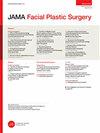Molecular Characterization of Lipoaspirates Used in Regenerative Head and Neck Surgery.
Q1 Medicine
引用次数: 7
Abstract
Importance Adipose-derived mesenchymal stem cells (ASCs) have been used commonly in regenerative medicine and increasingly for head and neck surgical procedures. Lipoaspiration with centrifugation is purported to be a mild method for the extraction of ASCs used for autologous transplants to restore tissue defects or induce wound healing. The content of ASCs, their paracrine potential, and cellular potential in wound healing have not been explored for this method to our knowledge. Objective To evaluate the characteristics of lipoaspirates used in reconstructive head and neck surgical procedures with respect to wound healing. Design, Setting, and Participants This case series study included 15 patients who received autologous fat injections in the head and neck during surgical procedures at a tertiary referral center. The study was performed from October 2017 to November 2018, and data were analyzed from October 2017 to February 2019. Main Outcomes and Measures Excessive material of lipoaspirates from subcutaneous abdominal fatty tissue was examined. Cellular composition was analyzed using immunohistochemistry (IHC) and flow cytometry, and functionality was assessed through adipose, osteous, and chondral differentiation in vitro. Supernatants were tested for paracrine ASC functions in fibroblast wound-healing assays. Enzyme-linked immunosorbent assay measurement of tumor necrosis factor (TNF), vascular endothelial growth factor (VEGF), stromal-derived factor 1α (SDF-1α), and transforming growth factor β3 (TGF-β3) was performed. Results Among the 15 study patients (8 [53.3%] male; mean [SD] age at the time of surgery, 63.0 [2.8] years), the stromal vascular fraction (mean [SE], 53.3% [4.2%]) represented the largest fraction within the native lipoaspirates. The cultivated cells were positive for CD73 (mean [SE], 99.90% [0.07%]), CD90 (99.40% [0.32%]), and CD105 (88.54% [2.74%]); negative for CD34 (2.70% [0.45%]) and CD45 (1.74% [0.28%]) in flow cytometry; and negative for CD14 (10.56 [2.81] per 300 IHC score) and HLA-DR (6.89 [2.97] per 300 IHC score) in IHC staining; they differentiated into osteoblasts, adipocytes, and chondrocytes. The cultivated cells showed high expression of CD44 (mean [SE], 99.78% [0.08%]) and CD273 (82.56% [5.83%]). The supernatants were negative for TNF (not detectable) and SDF-1α (not detectable) and were positive for VEGF (mean [SE], 526.74 [149.84] pg/mL for explant supernatants; 528.26 [131.79] pg/106 per day for cell culture supernatants) and TGF-β3 (mean [SE], 22.79 [3.49] pg/mL for explant supernatants; 7.97 [3.15] pg/106 per day for cell culture supernatants). Compared with control (25% or 50% mesenchymal stem cell medium), fibroblasts treated with ASC supernatant healed the scratch-induced wound faster (mean [SE]: control, 1.000 [0.160]; explant supernatant, 1.369 [0.070]; and passage 6 supernatant, 1.492 [0.094]). Conclusions and Relevance The cells fulfilled the international accepted criteria for mesenchymal stem cells. The lipoaspirates contained ASCs that had the potential to multidifferentiate with proliferative and immune-modulating properties. The cytokine profile of the isolated ASCs had wound healing-promoting features. Lipoaspirates may have a regenerative potential and an application in head and neck surgery. Level of Evidence NA.用于再生头颈部手术的吸脂剂的分子特性。
重要性脂肪来源的间充质干细胞(ASCs)已广泛用于再生医学,并越来越多地用于头颈外科手术。离心抽脂被认为是一种温和的提取ASCs的方法,用于自体移植以修复组织缺陷或诱导伤口愈合。据我们所知,这种方法尚未探索ASCs的含量、其旁分泌潜力和伤口愈合中的细胞潜力。目的评价吸脂器在头颈部重建手术中的伤口愈合特点。设计、设置和参与者这项病例系列研究包括15名在三级转诊中心接受手术过程中头部和颈部自体脂肪注射的患者。该研究于2017年10月至2018年11月进行,数据分析于2017年11月至2019年2月。主要结果和测量方法检查了腹部皮下脂肪组织中脂肪抽吸物的过量物质。使用免疫组织化学(IHC)和流式细胞术分析细胞组成,并通过体外脂肪、骨和软骨分化评估功能。在成纤维细胞伤口愈合测定中测试上清液的旁分泌ASC功能。采用酶联免疫吸附法测定肿瘤坏死因子(TNF)、血管内皮生长因子(VEGF)、基质衍生因子1α(SDF-1α)和转化生长因子β3(TGF-β3)。结果在15名研究患者中(8名[55.3%]男性;手术时的平均[SD]年龄为63.0[2.8]岁),基质血管分数(平均[SE],53.3%[4.2%])是天然脂肪抽吸物中最大的分数。培养的细胞对CD73(平均[SE],99.90%[0.07%])、CD90(99.40%[0.32%])和CD105(88.54%[2.74%])呈阳性;流式细胞术中CD34(2.70%[0.45%])和CD45(1.74%[0.28%])呈阴性;在IHC染色中CD14(10.56[2.81]每300 IHC评分)和HLA-DR(6.89[2.97]每300 IHC评分)呈阴性;它们分化为成骨细胞、脂肪细胞和软骨细胞。培养的细胞显示出CD44(平均[SE],99.78%[0.08%])和CD273(82.56%[5.83%])的高表达。上清液对TNF(不可检测)和SDF-1α呈阴性,对VEGF呈阳性(外植体上清液的平均[SE]526.74[149.84]pg/mL;细胞培养上清液的平均每天528.26[131.79]pg/106)和TGF-β3(平均[SE],22.79[3.49]外植体上清液为pg/mL;细胞培养上清液每天7.97[3.15]pg/106)。与对照组(25%或50%间充质干细胞培养基)相比,ASC上清液处理的成纤维细胞愈合划痕诱导的伤口更快(平均[SE]:对照组,1.000[0.160];外植体上清液,1.369[0.070];传代6上清液,1.492[0.094])。脂肪抽吸物含有具有增殖和免疫调节特性的多分化潜能的ASCs。分离的ASCs的细胞因子谱具有促进伤口愈合的特征。吸脂器可能具有再生潜力,并在头颈部手术中应用。证据等级NA。
本文章由计算机程序翻译,如有差异,请以英文原文为准。
求助全文
约1分钟内获得全文
求助全文
来源期刊

JAMA facial plastic surgery
SURGERY-
CiteScore
4.10
自引率
0.00%
发文量
0
期刊介绍:
Facial Plastic Surgery & Aesthetic Medicine (Formerly, JAMA Facial Plastic Surgery) is a multispecialty journal with a key mission to provide physicians and providers with the most accurate and innovative information in the discipline of facial plastic (reconstructive and cosmetic) interventions.
 求助内容:
求助内容: 应助结果提醒方式:
应助结果提醒方式:


